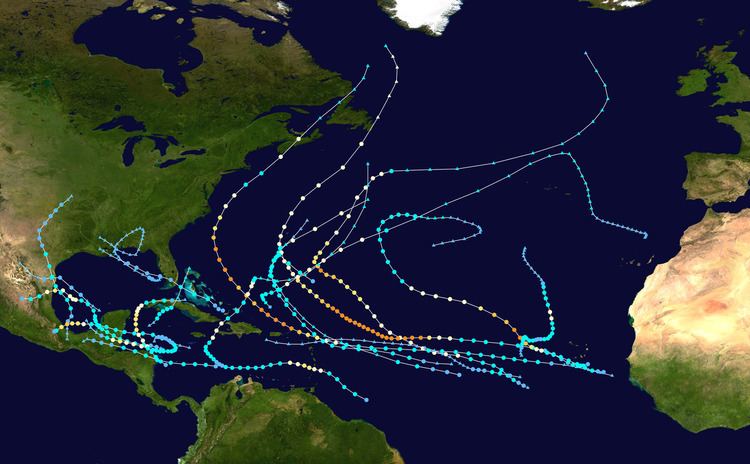 | ||
The 2010 Atlantic hurricane season was one of the most active Atlantic hurricane seasons since records began in 1851 in which nineteen named storms formed. The season officially began on June 1 (with Hurricane Alex, the first hurricane of the season forming on June 15) and ended on November 30, dates that conventionally delimit the period of each year when most tropical cyclones develop in the Atlantic basin. The season's final storm, Hurricane Tomas, dissipated on November 7.
Contents
The season produced twenty-one tropical cyclones, of which nineteen strengthened into tropical storms; twelve became hurricanes, and five further intensified into major hurricanes. The two most significant storms of the season, in terms of damage and loss of life, were hurricanes Igor and Tomas. Igor was one of the largest storms by gale diameter on record, and one that attained maximum sustained winds of 155 mph (250 km/h) before striking Newfoundland as a much weaker storm several days later. Tomas was a late-season tropical cyclone that rapidly intensified to reach maximum sustained winds of 100 mph (160 km/h) as it entered the eastern Caribbean Sea. Though the system did not make landfall, it severely affected the Greater Antilles, and impacted the southeastern Bahamas as a tropical storm before quickly moving into the open Atlantic.
This timeline documents tropical cyclone formations, strengthening, weakening, landfalls, extratropical transitions, and dissipations during the season. It includes information that was not released in situ, meaning that data from post-storm reviews by the National Hurricane Center, such as a storm that was not initially warned upon, has been included.
June
June 1
June 25
June 26
June 27
June 30
July
July 1
July 2
July 8
July 9
July 22
July 23
July 25
August
August 2
August 3
August 5
August 8
August 10
August 11
August 21
August 22
August 23
August 25
August 26
August 27
August 28
August 29
August 30
August 31
September
September 1
September 2
September 3
September 4
September 5
September 6
September 7
September 8
September 9
September 10
September 12
September 14
September 15
September 16
September 17
September 18
September 20
September 21
September 22
September 23
September 24
September 25
September 26
September 28
September 29
October
October 6
October 7
October 8
October 9
October 10
October 11
October 12
October 13
October 14
October 15
October 20
October 21
October 24
October 25
October 26
October 28
October 29
October 30
October 31
November
November 1
November 3
November 5
November 6
November 7
November 8
November 30
